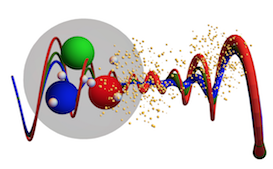Speaker
Description
In this talk, we present our ongoing work on the inclusion of string interactions, namely rope hadronization in heavy ion collisions, as an alternative to QGP. Rope hadronization, where strings in close proximity form higher-order colour multiplets, has been earlier observed to explain QGP-like effects in p-p collisions such as strangeness enhancement.
The main challenge involved in implementing such mechanisms in dense environments is that the majority of strings in dense systems lie in random spatial orientation, which makes calculating the force among all strings during an event a complex problem.
In our approach, we use a special Lorentz frame, where a pair of string pieces are in parallel planes with respect to each other. Hence, for a whole Pythia/Angantyr event, every possible string pair is boosted to this frame to calculate the rope effects.
This novel approach of rope hadronization can produce the cumulative result of generating QGP-like effects in dense environments, for both small and large systems. In this talk, we present our new implementation (https://arxiv.org/abs/2205.11170) - the Gleipnir framework - in Pythia8/Angantyr and results from strangeness yield analyses performed in high-multiplicity p-p and heavy-ion collisions with comparison to data for minimum bias events.

